Mexico’s Caballito Peso
by Allan Scheinauthor of Mexican Beauty - Belleza Mexicana Un Peso Caballito,
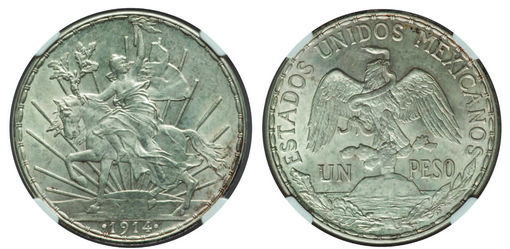
The Caballito (Little Horse) Peso was designed with great contemplation, artistry and social relevance by the French engraver, designer and medalist Charles Pillet. It depicts Liberty on Horseback.
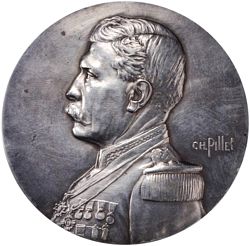
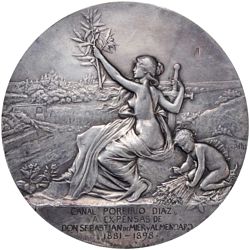
medal commemorating the Canal Porforio Díaz
In 1907, Pillet had designed a medal to commemorate the Canal Porforio Díaz in Mexico City. This medal featured Diaz in profile and he liked it so much he requested the Paris Mint (Monnaie de Paris) to have Pillet submit a design for Mexico's new coinage. This was his gateway opportunity for creating the Caballito.
The first patterns were of the Caballito design on a high relief 50 centavo planchette dated 1907. A single 1908 50 centavo is known, and a moderate number of the full sized 39mm 1909 patterns, marked "essai" meaning "trial". An estimated 36 +/- are believed to exist with either a brilliant or matte finish. There are three different edge treatments; sunken letters, raised letters and smooth edge.
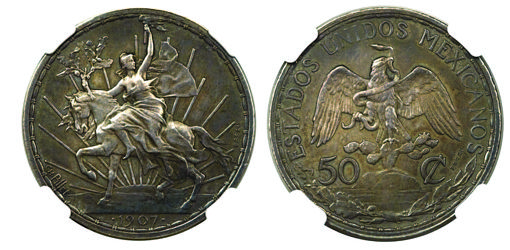
This first presentation was not embraced, but was again presented in the Un Peso form bearing the date 1909. This proposed coin was wisely approved for production and replaced the preceding Liberty Cap and Rays design last minted in 1909. The Caballito series was minted in Mexico City 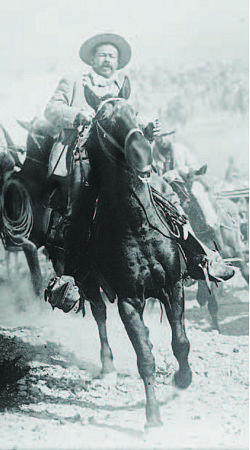 from 1910 through 1914. 1910 marked the 100th anniversary of the Mexican War of Independence (1810 – 1821), and the Caballito is often considered to be Mexico’s first commemorative coin. 1910 also marked the beginning of the Mexican Revolution, a civil revolt that grew into a many sided civil war against the autocratic regime of Porfirio Diaz. For nearly a decade this major socio-political conflict was fought, shaping the future of Mexico. Memorable names like Emiliano Zapata, Pancho Villa and Francisco Madero made headline news around the world, and the image of men on horseback was continually before the public’s eye in the newspapers of the day.
from 1910 through 1914. 1910 marked the 100th anniversary of the Mexican War of Independence (1810 – 1821), and the Caballito is often considered to be Mexico’s first commemorative coin. 1910 also marked the beginning of the Mexican Revolution, a civil revolt that grew into a many sided civil war against the autocratic regime of Porfirio Diaz. For nearly a decade this major socio-political conflict was fought, shaping the future of Mexico. Memorable names like Emiliano Zapata, Pancho Villa and Francisco Madero made headline news around the world, and the image of men on horseback was continually before the public’s eye in the newspapers of the day.
The Caballito Peso was produced at the same period of time when US coinage was being radically re-designed thanks in great part to the influence of President Theodore Roosevelt. In 1907, the $20 Gold double Eagle design of Augustus Saint Gaudens was introduced, replacing the Coronet $20 Double Eagle, minted from 1850 through 1907. 1907 also saw the introduction of the $10 Gold Indian, also by Saint Gaudens, replacing the $10 Coronet Gold Eagle which was initially introduced into circulation in 1838. 1908 saw the introduction of the $2.50 Gold Indian Quarter Eagle and the $5 Gold Indian Half Eagle, both designed by Boston sculptor Bella Lyon Pratt, a student of Saint Gaudens. These new coins are even today considered amongst the most beautiful designs ever minted in US coinage, and set the stage for additional beauty and originality in the decade to follow. The Winged Liberty or Mercury dime, the Walking Liberty half dollar, the Standing Liberty quarter and the Buffalo nickel were each a testament to the renaissance of early 20th century coin reformation. The Caballito fits perfectly into this era of coin artistry, with a lasting graphic and artistic beauty that stands on its own in timeless majesty.
The Reverse
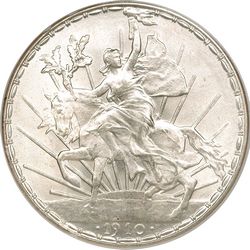
The reverse depicts a young woman rider, symbolically representing Liberty, side sitting on an unshod Mexican bucking horse that carries no saddle. Both the horse and rider face to the left. The female rider holds a torch raised high in her left hand as she looks to the rear while urging the horse forward. This could represent moving forward as a people while looking to the past which is behind her. The flames of the torch flow horizontally to the right indicating movement to the horse and rider’s left. In her right hand she holds a forked branch from an oak, while propping her forearm up along the horse’s neck. She holds no reins nor does the horse appear to even have a bridle, thus the reference to a bucking or wild horse. At this period in Mexico’s history, motor vehicles were scarce, and horses both supported and were integral to the entire economy of the nation. Ms. Liberty is wrapped in loose garments with numerous heavy fabric folds. It might appear that she wears a flowing cape, but this is simply loose fabric billowing out as she rides. She sits astride the horse barefoot with legs hanging off to the left side of the horse’s torso, the viewing profile. Both the rider’s hair and her garment are windblown to her rear. Her upper chest, shoulders and arms are bare. During this period in history, such dress was considered progressive and may be a further expression of individual freedom on the part of the French designer. In his other works, Pillet regularly depicted nude female bodies in his artistry.
The horse itself is a magnificent creature, with its left foreleg raised high, the right rear leg stepping forward, its neck arched and mouth opened as if whinnying like horses will. It seems alive with energy and restless with intent of explosive movement. And so was the population of an entire nation. It has a long, beautiful flowing mane and tail, which is held somewhat high off its rump. Everything about this animal speaks of vigor, energy and restrained control. It is subservient to Liberty, and seemingly ready to race forward at her command. Its muscles and tendons are clearly defined adding to its graphic design and visual appeal. Its ears stand straight up and face forward in an alert posture.
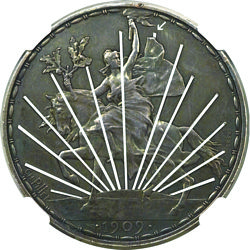 Behind the horse and rider is a radiant rising sun with its crown breaking above the earth sending 14 rays of light into the sky on the field behind the devices or raised design elements (one cannot be seen because it is hidden behind the horse’s right rear leg near the sun’s orb). Ironically, there are 13 sunbeams emanating from the rising sun’s orb itself, but 14 sunbeam rays pictured at the end of their line of travel. The ray directly to the right of Liberty’s raised arm has no beginning. This is a totally new discovery to my knowledge, which I first recognized while counting the sun’s rays for the above description the evening of Monday, 16 July 2012.
Behind the horse and rider is a radiant rising sun with its crown breaking above the earth sending 14 rays of light into the sky on the field behind the devices or raised design elements (one cannot be seen because it is hidden behind the horse’s right rear leg near the sun’s orb). Ironically, there are 13 sunbeams emanating from the rising sun’s orb itself, but 14 sunbeam rays pictured at the end of their line of travel. The ray directly to the right of Liberty’s raised arm has no beginning. This is a totally new discovery to my knowledge, which I first recognized while counting the sun’s rays for the above description the evening of Monday, 16 July 2012.
Surrounding the outer edge of the reverse face is an alternating pattern of small double oval denticles that sit at a 90 degree angle to the rim. These are interspersed with considerably longer narrow oval denticles sitting parallel to the almost flat raised rim. The design is reminiscent of elaborate beadwork and jewelry of the period. There are 35 long denticles visible, with space for two behind the torch flame, but not visible. The denticle pattern sits close beside, but fully separated from the rim. On some coins the smaller double beads may be slightly raised and actually take only a small dip down before joining the rim itself.

Denticular pattern
The date on the coin sits in the space below the textured ground the horse stands upon, with a dot on either side. There are no legends or mottos, or any wording on this side of the coin; just the date.
The Obverse
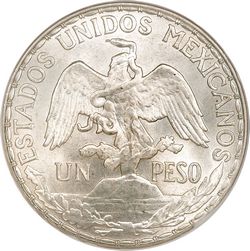
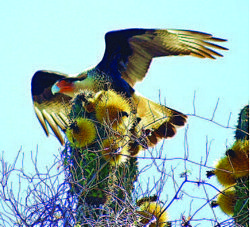 The obverse is often mistaken for the reverse since it is not as attention demanding. Yet it is equally as beautiful and powerful in its graphic presentation and historical message and use. The overall design of the obverse is the historical Mexican coat of arms. It shows a Mexican Eagle or Caracara (Mexico’s national bird), with wings spread standing on a nopal or prickly pear cactus supported by only its left leg (right facing leg). The eagle (often erroneously described as a Golden Eagle) looks to the right while holding a rattlesnake in its beak near the head. The snake’s head is above the eagle’s, and faces left. The eagle grasps the tail of the snake with its left facing talon in its raised leg. In overall length, the snake is longer than the eagle. The eagle appears strong and proud, and visually impressive.
The obverse is often mistaken for the reverse since it is not as attention demanding. Yet it is equally as beautiful and powerful in its graphic presentation and historical message and use. The overall design of the obverse is the historical Mexican coat of arms. It shows a Mexican Eagle or Caracara (Mexico’s national bird), with wings spread standing on a nopal or prickly pear cactus supported by only its left leg (right facing leg). The eagle (often erroneously described as a Golden Eagle) looks to the right while holding a rattlesnake in its beak near the head. The snake’s head is above the eagle’s, and faces left. The eagle grasps the tail of the snake with its left facing talon in its raised leg. In overall length, the snake is longer than the eagle. The eagle appears strong and proud, and visually impressive.
The cactus has a central supporting post-like middle section from ground to eagle’s foot, with three cactus paddles or blades (pencas) extending to each side. Each blade has raised circular bumps which represent cactus fruit, buds or blossoms. The cactus sits on a raised rocky outcropping or island surrounded by the waters of Lake Texcoco with its windblown waves undulating horizontally towards each side of the coin.
Around the perimeter of the coin, but inside the same denticle design pattern is the legend ESTADOS UNIDOS MEXICANOS above and a wreath below the design. The wreath is divided into two different halves, with the left portion comprised of an Encino Oak branch with five leaves and several acorns while the right half is made up of a Laurel branch with seven leaves, several berries and small berry clusters. The very bottom of the wreath shows the branches overlapping each other and bound together with a ribbon. On the field below the two cactus blade branches is the denomination UN PESO.
The denticle pattern around the outer face is identical as on the reverse, except it is complete and contains 37 elongated oval beads.
The Coat of Arms
The State Emblem, was first adopted in 1823 and the eagle and snake on a cactus have served ever since as the Emblem of Arms of the successive Republics and Empires. It recalls an old Indian legend: The Aztec people were guided by their god Huitzilopochtli to seek a place where an eagle landed on a prickly-pear cactus, eating a snake... After many years of wandering they found the sign on a small swampy island in Lake Texcoco. They named their new home Tenochtitlan ("Place of the Prickly Pear Cactus"). In 1325 they built a city on the site of the island in the lake. In time, the lake was drained and became an agricultural center. Tenochtitlan is now the center of Mexico City.
Although the same coat of arms has appeared on the obverse of Mexican coins for nearly two centuries, its style has varied from coin to coin, as depicted by the designer – engraver of the individual issue.
The Edge
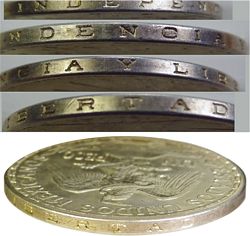 The outer edge around the coin is flat but with sunken or recessed lettering that reads INDEPENDENCIA Y LIBERTAD. The legend is always fully impressed into the edge. The lettering itself is inconsistent in direction of reading. On some it can be read right side up from the obverse but upside down on the reverse, and on others the opposite. This is accounted for by the edge letters being impressed by being run through a parallel bar roller before striking.
The outer edge around the coin is flat but with sunken or recessed lettering that reads INDEPENDENCIA Y LIBERTAD. The legend is always fully impressed into the edge. The lettering itself is inconsistent in direction of reading. On some it can be read right side up from the obverse but upside down on the reverse, and on others the opposite. This is accounted for by the edge letters being impressed by being run through a parallel bar roller before striking.
Nowhere on the production issues is there evidence of Pillets' name or initials, or of any mint mark. However, all coins were struck in Mexico City.
Symbolism of the Caballito
A great depth of forethought and insight is incorporated into the elements of the Caballito Peso. Liberty on Horseback is reminiscent of the original equestrian bronze sculpture “El Caballito” by Manuel Tolsa of King Charles IV of Spain.
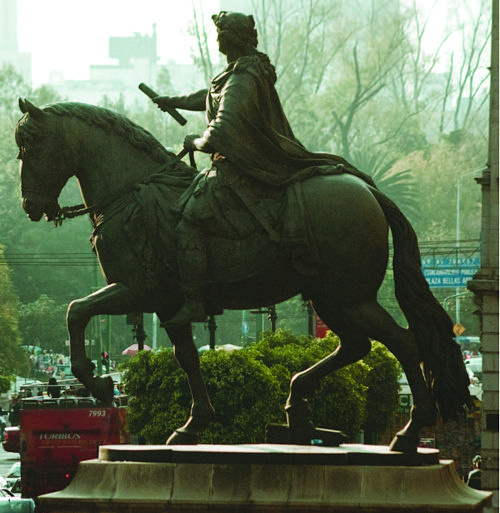
This world-renowned monumental statue has resided in Mexico City ever since its casting in August of 1802, and installation in 1803. It has survived in spite of much controversy and anti-Hispanic sentiment over the years, especially in the years following its installation. There were protests in the years following the War of Independence, and talk of removing it for melting down to use for the manufacturing of cannons (it is a huge installation that contains 26 tons of bronze). The stance of the horse on the Caballito Peso is nearly identical to that of the Tolsa sculpture. This cannot be a coincidence, since the coin essentially commemorates the overthrow of Spanish Colonial rule in 1810 and was issued exactly 100 years after the beginning of the Mexican War of Independence. Liberty sitting astride the horse of King Charles is a clear statement of independence, reinforcing the cultural and historical reference, and contemporizing the onset of civil revolts during the year of issuance in 1910. The fact that Liberty is riding a horse without a saddle, reins, halter or bridle symbolizes Mexicans living freely, without restraint or domination. Although the designs were conceived several years earlier by Pillet, the timing of the coin’s issuance is, in my opinion, intentional, and not at all coincidental.
Liberty holds her right hand high overhead bearing a torch, symbolizing enlightenment and hope. She looks to her rear as though beckoning the citizens to follow, inspiring leadership and freedom from the autocracy in power at the time.
A rising radiant sun symbolizes the dawn of a new era. This symbolism has been used as far back as the Egyptians where a symbol of the rising sun referred to the Egyptian sun god Chepri (or Khepera), and also meant protection from evil. A rising sun is often used as a symbol of glory and brilliance, representing happiness, life, hope and spirituality. It also symbolizes the emergence of light winning the battle over darkness, which in this instance refers to the citizens prevailing over early Spanish Colonial rule and the autocracy of Porfirio Diaz, in power in 1910.
Without a doubt there are many interpretations that can be inferred through Pillet’s design. Yet for all its symbolism and relevance to the cultural and historical background of Mexico, it stands on its own as one of the most beautiful designs ever created for any coin of any nation throughout thousands of years of numismatic production. No matter the many countless hours I have spent gazing upon and studying the various Caballitos I have encountered and those few I own, I have never grown tired or bored doing so. It is a testament to the brilliance of Pillet and his insight into the life and times of the people of Mexico. Few designers have ever created such lovely and enduring imagery while including such perfectly on target inferences of social and cultural significance.
